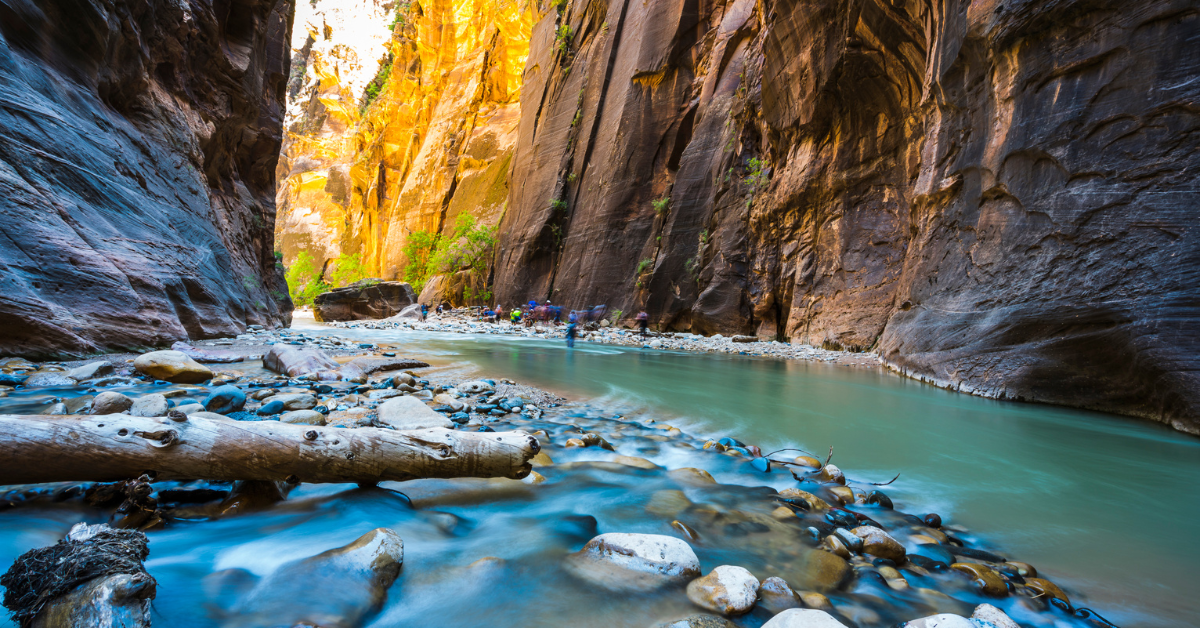All "63" U.S. National Parks: The Ultimate Guide
The United States has more national parks than any other country on earth, but you've probably only heard of maybe a few of them. Here's a full list of all 63 U.S. National
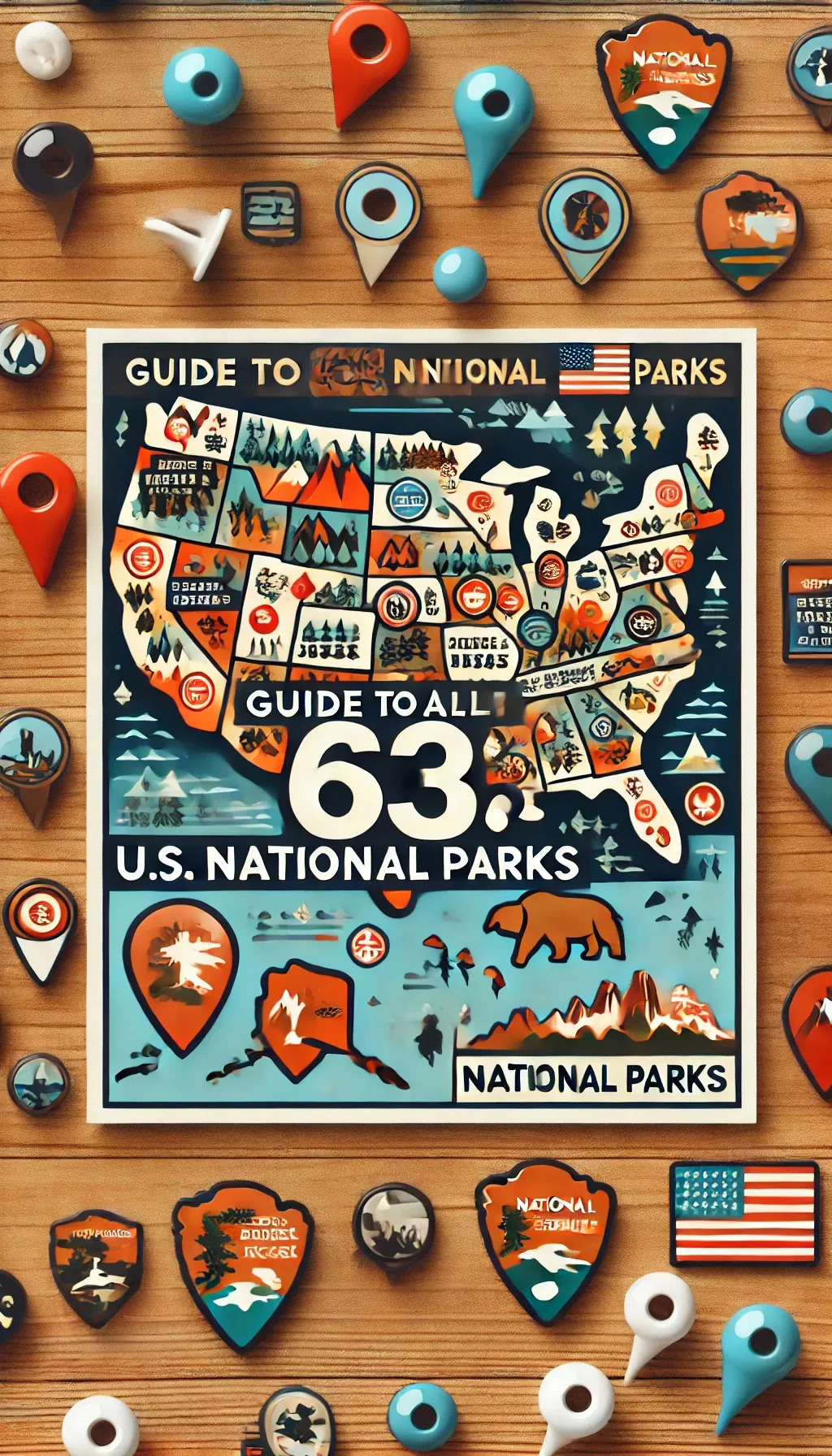
Acadia National Park
Park Highlights
- Located in Maine, offering stunning coastal landscapes and rugged mountains.
- Encompasses over 47,000 acres, including part of Mount Desert Island.
- Known for its diverse ecosystems, including forests, lakes, and ocean shoreline.
Park Attractions
- Cadillac Mountain: The highest point on the U.S. East Coast, famous for its sunrise views.
- Carriage Roads: Over 45 miles of scenic roads for biking and walking, designed by John D. Rockefeller Jr.
- Sand Beach: A popular spot for swimming and relaxing with beautiful ocean views.
- Jordan Pond: Known for its crystal-clear waters and iconic views of the Bubbles mountains.
Park History
- Founded: Established as a national park in 1919.
- Reason for Establishment: To preserve the rugged beauty of the Atlantic coast.
- Expansion: Originally named Lafayette National Park, it was renamed Acadia in 1929 to honor the region's early explorers and settlers.
American Samoa National Park
Park Highlights
- Located in the South Pacific, covering parts of three islands: Tutuila, Ofu, and Ta‘ū.
- Features lush tropical rainforests, coral reefs, and white sandy beaches.
- Offers a unique blend of natural beauty and Samoan culture.
Park Attractions
- Ofu Beach: Known for its pristine coral reefs and excellent snorkeling opportunities.
- Polynesian Culture: Visitors can experience traditional Samoan customs and villages.
- Mount Alava: Offers hiking trails with panoramic views of the islands and ocean.
Park History
- Founded: Established in 1988.
- Reason for Establishment: To preserve the unique tropical ecosystems and cultural heritage of American Samoa.
- Expansion: Managed through a partnership with local Samoan communities to protect traditional land use.
Arches National Park
Park Highlights
- Located in eastern Utah, home to over 2,000 natural stone arches.
- Known for its striking red rock landscapes and unique geological formations.
- Offers a stunning desert environment with diverse flora and fauna.
Park Attractions
- Delicate Arch: The park's most famous landmark, a freestanding arch accessible by a popular hiking trail.
- Double Arch: Two arches that share a common end, providing a unique formation and great photo opportunities.
- Landscape Arch: One of the longest natural arches in the world, located along the Devils Garden Trail.
- Fiery Furnace: A maze-like area of narrow sandstone canyons that require a guided tour or permit to explore.
Park History
- Founded: Established as a national monument in 1929 and became a national park in 1971.
- Reason for Establishment: To protect its significant natural arches and unique geologic resources.
- Expansion: The park's boundaries were expanded in the 1960s and 1970s to protect additional geological features and archaeological sites.
Badlands National Park
Park Highlights
- Located in South Dakota, featuring dramatic landscapes of eroded buttes, pinnacles, and spires.
- Known for its rich fossil beds, showcasing ancient mammals and other prehistoric creatures.
- Encompasses a vast prairie ecosystem with diverse wildlife.
Park Attractions
- Badlands Loop Road: A scenic drive that offers stunning views of the park's unique landscapes.
- Fossil Exhibit Trail: An informative trail showcasing fossil replicas and the area's paleontological history.
- Notch Trail: A popular hiking trail that leads to a viewpoint overlooking the White River Valley.
- Wildlife Viewing: Home to bison, bighorn sheep, and prairie dogs, providing excellent wildlife watching opportunities.
Park History
- Founded: Established as a national monument in 1939 and became a national park in 1978.
- Reason for Establishment: To protect the area's unique geologic formations and fossil resources.
- Expansion: The park's boundaries were adjusted several times to incorporate more significant fossil sites and prairie lands.
Big Bend National Park
Park Highlights
- Located in Texas, along the Rio Grande River, featuring diverse desert landscapes and rugged mountains.
- Known for its rich biodiversity, including over 1,200 species of plants and a variety of wildlife.
- Offers vast wilderness areas for exploration and solitude.
Park Attractions
- Santa Elena Canyon: A dramatic limestone canyon carved by the Rio Grande, accessible by hiking and river trips.
- Chisos Basin: A mountainous area with scenic vistas, hiking trails, and a variety of ecosystems.
- Hot Springs: Natural hot springs along the Rio Grande, offering a unique soaking experience.
- Rio Grande Village: A popular camping and hiking area with stunning views of the river and surrounding mountains.
Park History
- Founded: Established as a national park in 1944.
- Reason for Establishment: To preserve the unique natural and cultural resources of the Chihuahuan Desert region.
- Expansion: The park's boundaries have remained largely unchanged since its establishment, maintaining its vast wilderness character.
Biscayne National Park
Park Highlights
- Located in Florida, protecting a unique marine ecosystem including coral reefs, mangrove forests, and clear blue waters.
- Known for its vibrant underwater life and opportunities for water-based recreation.
- Offers a rich cultural history, including shipwrecks and historic sites.
Park Attractions
- Boca Chita Key: A popular island destination with a historic lighthouse and picnic areas.
- Coral Reefs: Offers excellent snorkeling and diving opportunities to explore vibrant coral formations and marine life.
- Elliott Key: The park's largest island, featuring hiking trails and camping opportunities.
- Maritime Heritage Trail: An underwater trail showcasing historic shipwrecks and archaeological sites.
Park History
- Founded: Established as a national monument in 1968 and became a national park in 1980.
- Reason for Establishment: To protect the area's unique marine ecosystems and cultural heritage.
- Expansion: The park's boundaries were expanded in the 1980s to include more of the surrounding waters and islands.
Black Canyon of the Gunnison National Park
Park Highlights
- Located in Colorado, known for its steep, dramatic cliffs and deep canyons carved by the Gunnison River.
- Offers some of the steepest cliffs and oldest rock formations in North America.
- Provides opportunities for solitude and wilderness exploration.
Park Attractions
- South Rim Road: A scenic drive with numerous overlooks offering breathtaking views of the canyon.
- Painted Wall: The tallest cliff in Colorado, featuring intricate rock patterns visible from the canyon rim.
- Gunnison River: Offers challenging whitewater rafting and fishing opportunities in its rugged waters.
- North Rim: A less-visited area of the park with hiking trails and panoramic canyon views.
Park History
- Founded: Established as a national monument in 1933 and became a national park in 1999.
- Reason for Establishment: To protect the unique geologic features and dramatic landscapes of the canyon.
- Expansion: The park's boundaries were expanded in the 1990s to include more of the surrounding canyonlands and river areas.
Bryce Canyon National Park
Park Highlights
- Located in Utah, famous for its unique rock formations known as hoodoos.
- Offers stunning red, orange, and pink landscapes that create a surreal and picturesque setting.
- Known for its clear night skies, perfect for stargazing.
Park Attractions
- Bryce Amphitheater: The park's main attraction, featuring a vast array of hoodoos and scenic overlooks.
- Sunrise and Sunset Points: Popular viewpoints for capturing the park's vibrant colors at dawn and dusk.
- Navajo Loop Trail: A popular hiking trail that descends into the canyon, offering close-up views of the hoodoos.
- Stargazing: Renowned for its dark skies, offering excellent opportunities for viewing stars and celestial events.
Park History
- Founded: Established as a national monument in 1923 and became a national park in 1928.
- Reason for Establishment: To preserve the unique geological formations and colorful landscapes.
- Expansion: The park's boundaries have remained largely unchanged, focusing on protecting the amphitheater and surrounding areas.
Canyonlands National Park
Park Highlights
- Located in Utah, known for its vast and diverse landscapes, including deep canyons, towering mesas, and intricate rock formations.
- Divided into four districts, each offering unique experiences and stunning scenery.
- Offers opportunities for adventure and solitude in a rugged desert environment.
Park Attractions
- Island in the Sky: A district known for its expansive views and easily accessible overlooks.
- The Needles: Offers a network of hiking trails through colorful spires and canyons.
- The Maze: A remote district known for its challenging terrain and wilderness experiences.
- White Rim Road: A popular 4WD and mountain biking route offering breathtaking views of the canyons below.
Park History
- Founded: Established as a national park in 1964.
- Reason for Establishment: To protect the unique desert landscapes and geological features of the Colorado Plateau.
- Expansion: The park's boundaries were expanded in the 1970s to include more of the surrounding canyonlands and river areas
Capitol Reef National Park
Park Highlights
- Located in Utah, known for its colorful canyons, rugged cliffs, and the Waterpocket Fold, a unique geological monocline extending nearly 100 miles.
- Offers diverse landscapes, including rock formations, desert valleys, and lush fruit orchards.
- Known for its remote, less-crowded experience compared to other national parks in Utah.
Park Attractions
- Scenic Drive: A 7.9-mile road offering stunning views of Capitol Reef’s dramatic landscapes.
- Fruita Historic District: Features orchards where visitors can pick fruit and explore historical structures like the Gifford Homestead.
- Hickman Bridge: A popular hiking trail leading to a natural stone arch.
- Cathedral Valley: Known for its striking monoliths and remote desert scenery, accessible by 4WD roads.
Park History
- Founded: Established as a national monument in 1937 and became a national park in 1971.
- Reason for Establishment: To protect the unique geologic features, including the Waterpocket Fold, and the historical resources of the Fruita area.
- Expansion: The park’s boundaries were expanded in 1969 to include additional natural and historical sites.
Carlsbad Caverns National Park
Park Highlights
- Located in New Mexico, home to a vast underground cave system with over 119 known caves.
- Known for its impressive limestone formations, including stalactites, stalagmites, and flowstones.
- Offers one of the largest and most accessible cave chambers in North America, known as the Big Room.
Park Attractions
- Big Room: A self-guided tour of the largest chamber, featuring stunning formations and a 1.25-mile walking path.
- Bat Flight Program: A popular evening event where visitors can watch thousands of bats emerge from the cave.
- King's Palace Tour: A ranger-guided tour exploring some of the most elaborate cave decorations.
- Natural Entrance Trail: A steep descent into the cave, providing a sense of the cave’s scale and formation process.
Park History
- Founded: Established as a national monument in 1923 and became a national park in 1930.
- Reason for Establishment: To protect the significant cave formations and geological features.
- Expansion: The park's boundaries were expanded in the 1930s to include additional caves and surface landscapes.
Channel Islands National Park
Park Highlights
- Located off the coast of Southern California, encompassing five remote islands: Anacapa, Santa Cruz, Santa Rosa, San Miguel, and Santa Barbara.
- Known for its unique island ecosystems, diverse marine life, and rich cultural history.
- Offers opportunities for solitude and adventure in a pristine natural setting.
Park Attractions
- Anacapa Island: Known for its iconic lighthouse and dramatic sea cliffs.
- Santa Cruz Island: Offers hiking trails, kayaking opportunities, and diverse wildlife, including the endangered island fox.
- Snorkeling and Diving: Provides access to vibrant kelp forests and abundant marine life.
- Whale Watching: Offers opportunities to see blue whales, humpback whales, and other marine mammals.
Park History
- Founded: Established as a national monument in 1938 and became a national park in 1980.
- Reason for Establishment: To preserve the unique natural and cultural resources of the Channel Islands.
- Expansion: The park’s boundaries were expanded in 1980 to include additional marine and terrestrial areas.
Congaree National Park
Park Highlights
- Located in South Carolina, known for its old-growth bottomland hardwood forest, one of the tallest in the southeastern United States.
- Offers a rich diversity of plant and animal life, including champion trees and numerous bird species.
- Known for its unique floodplain ecosystem, which supports diverse habitats and wildlife.
Park Attractions
- Boardwalk Loop Trail: A 2.4-mile elevated trail through the forest, providing easy access to the park's diverse ecosystems.
- Canoeing and Kayaking: Offers paddling opportunities on Cedar Creek, allowing visitors to explore the park’s waterways.
- Weston Lake Loop Trail: A popular hiking trail with views of old-growth trees and wildlife.
- Ranger-Led Programs: Provide insights into the park’s natural and cultural history.
Park History
- Founded: Established as a national monument in 1976 and became a national park in 2003.
- Reason for Establishment: To protect one of the largest intact expanses of old-growth bottomland hardwood forest in the U.S.
- Expansion: The park’s boundaries have been expanded to include additional forest and floodplain areas.
Crater Lake National Park
Park Highlights
- Located in Oregon, home to the deepest lake in the United States, formed in the caldera of a collapsed volcano.
- Known for its strikingly blue water and surrounding cliffs, which rise up to 2,000 feet above the lake.
- Offers a pristine wilderness environment with diverse plant and animal life.
Park Attractions
- Rim Drive: A scenic 33-mile road encircling the lake, offering panoramic views and access to numerous overlooks.
- Wizard Island: A volcanic cinder cone that rises from the lake’s surface, accessible by boat tours.
- Cleetwood Cove Trail: The only trail that provides access to the lake shore for swimming and boat tours.
- Winter Recreation: Offers opportunities for cross-country skiing and snowshoeing.
Park History
- Founded: Established as a national park in 1902.
- Reason for Establishment: To preserve the unique geological features and natural beauty of Crater Lake.
- Expansion: The park’s boundaries have remained largely unchanged since its establishment.
Cuyahoga Valley National Park
Park Highlights
- Located in Ohio, spanning the distance between Cleveland and Akron, featuring rolling hills, forests, and wetlands.
- Offers a mix of natural beauty and cultural history, with historic farms and villages.
- Known for its rich biodiversity and scenic landscapes, including the Cuyahoga River.
Park Attractions
- Brandywine Falls: A 65-foot waterfall accessible by boardwalk and hiking trails.
- Towpath Trail: A popular multi-use trail following the historic Ohio & Erie Canal.
- Cuyahoga Valley Scenic Railroad: Offers scenic train rides through the park, showcasing its natural beauty and history.
- Kendall Lake: Provides opportunities for fishing, hiking, and picnicking.
Park History
- Founded: Established as a national recreation area in 1974 and became a national park in 2000.
- Reason for Establishment: To protect the scenic and historical resources of the Cuyahoga Valley.
- Expansion: The park’s boundaries have been expanded to include additional natural and cultural sites.
Death Valley National Park
Park Highlights
- Located in California and Nevada, known for its extreme desert landscapes, including salt flats, sand dunes, and rugged mountains.
- Home to the lowest point in North America, Badwater Basin, at 282 feet below sea level.
- Known for its extreme temperatures, reaching record highs during the summer months.
Park Attractions
- Badwater Basin: A vast salt flat and the lowest point in North America.
- Zabriskie Point: Offers stunning views of the park’s unique geological formations and colors.
- Mesquite Flat Sand Dunes: A popular area for hiking and photography, featuring picturesque sand dunes.
- Scotty's Castle: A historic mansion and visitor attraction in the northern part of the park.
Park History
- Founded: Established as a national monument in 1933 and became a national park in 1994.
- Reason for Establishment: To protect the unique desert landscapes and geological features.
- Expansion: The park’s boundaries were expanded in 1994 to include additional desert and mountain areas.
Denali National Park
Park Highlights
- Located in Alaska, home to North America’s tallest peak, Denali (formerly known as Mount McKinley).
- Encompasses six million acres of wild landscapes, including tundra, forests, and glaciers.
- Known for its abundant wildlife, including grizzly bears, wolves, and caribou.
Park Attractions
- Denali Park Road: A scenic road offering stunning views and access to hiking trails and wildlife viewing areas.
- Wonder Lake: Provides breathtaking views of Denali and the surrounding mountains.
- Sled Dog Kennels: Offers demonstrations of traditional Alaskan sled dog practices.
- Hiking and Backpacking: Provides numerous opportunities for exploring the park’s diverse landscapes.
Park History
- Founded: Established as Mount McKinley National Park in 1917 and became Denali National Park and Preserve in 1980.
- Reason for Establishment: To protect the wildlife and natural resources of the area.
- Expansion: The park was significantly expanded in 1980 to include additional wilderness areas and habitats.
Dry Tortugas National Park
Park Highlights
- Located off the coast of Florida, encompassing seven islands and the surrounding coral reefs.
- Known for its clear blue waters, abundant marine life, and historic Fort Jefferson.
- Offers opportunities for snorkeling, diving, and exploring remote island landscapes.
Park Attractions
- Fort Jefferson: A massive 19th-century coastal fort and one of the largest masonry structures in the Americas.
- Snorkeling and Diving: Renowned for its vibrant coral reefs, rich marine biodiversity, and several historic shipwrecks.
- Birdwatching: A sanctuary for migrating birds, providing a habitat for species like the sooty tern and brown noddy.
- Garden Key: The primary island for visitors, featuring the fort, campsites, and beautiful beaches.
Park History
- Founded: Established as a national monument in 1935 and became a national park in 1992.
- Reason for Establishment: To preserve the historic Fort Jefferson and the unique marine and island ecosystems.
- Expansion: Initially a military fort and prison, the area transitioned to national park status to protect its natural and historical resources.
Everglades National Park
Park Highlights
- Located in southern Florida, renowned for its vast wetland ecosystems and rich biodiversity.
- The largest tropical wilderness of any kind in the U.S. and a UNESCO World Heritage Site.
- Home to rare and endangered species like the American crocodile, manatee, and Florida panther.
Park Attractions
- Anhinga Trail: A popular boardwalk offering close encounters with wildlife like alligators and wading birds.
- Shark Valley: Features a 15-mile loop for biking and tram tours to see panoramic views and diverse ecosystems.
- Flamingo Visitor Center: Offers access to kayaking, birdwatching, and exploring the coastal areas of the park.
- Ten Thousand Islands: A network of mangrove islets, ideal for kayaking and spotting manatees and dolphins.
Park History
- Founded: Established as a national park in 1947.
- Reason for Establishment: To protect the unique ecosystem and its wildlife, preserving the natural flow of the Everglades.
- Expansion: The park has seen gradual boundary expansions to enhance protection for the surrounding ecosystems and wildlife corridors.
Gates of the Arctic National Park
Park Highlights
- Located in northern Alaska, known for its remote wilderness and pristine natural beauty.
- No roads or trails; offers a true backcountry experience in the Arctic environment.
- Encompasses the central Brooks Range and supports diverse Arctic wildlife.
Park Attractions
- Arrigetch Peaks: Stunning granite spires perfect for mountaineering and photography.
- Kobuk River: Known for its clear waters and opportunities for float trips and fishing.
- Caribou Migration: Witness the great migration of the Western Arctic caribou herd.
- Remote Hiking and Camping: Explore untracked wilderness in solitude and peace.
Park History
- Founded: Established as a national park and preserve in 1980.
- Reason for Establishment: To protect the natural landscapes and cultural heritage of the Arctic region.
- Expansion: The park was part of the Alaska National Interest Lands Conservation Act, expanding protection to large wilderness areas.
Gateway Arch National Park
Park Highlights
- Located in St. Louis, Missouri, commemorating the westward expansion of the United States.
- Features the iconic 630-foot-tall Gateway Arch, the tallest monument in the U.S.
- Offers historical insight into the nation's westward movement and expansion.
Park Attractions
- Gateway Arch: Take a tram ride to the top for panoramic views of St. Louis and the Mississippi River.
- Museum at the Gateway Arch: Explores the history of westward expansion and the building of the arch.
- Riverboat Cruises: Offers scenic cruises on the Mississippi River with views of the Arch.
- Old Courthouse: A historic site where the Dred Scott case was tried, pivotal in American history.
Park History
- Founded: Established as Jefferson National Expansion Memorial in 1935 and redesignated as Gateway Arch National Park in 2018.
- Reason for Establishment: To honor Thomas Jefferson and the westward expansion of the United States.
- Expansion: The park was renamed and expanded to emphasize its significance as a symbol of America's frontier spirit.
Glacier National Park
Park Highlights
- Located in Montana, known for its rugged mountain landscapes, pristine lakes, and glaciers.
- Part of the larger Waterton-Glacier International Peace Park, a UNESCO World Heritage Site.
- Offers diverse ecosystems, abundant wildlife, and breathtaking scenic beauty.
Park Attractions
- Going-to-the-Sun Road: A 50-mile scenic drive offering stunning vistas and access to popular trails.
- Many Glacier: A region known for its spectacular scenery, wildlife, and hiking opportunities.
- Grinnell Glacier: Accessible via a challenging hike, offering close views of glaciers and alpine landscapes.
- Wildlife Viewing: Home to grizzly bears, mountain goats, and bighorn sheep, offering excellent wildlife observation.
Park History
- Founded: Established as a national park in 1910.
- Reason for Establishment: To preserve the unique natural beauty and biodiversity of the northern Rocky Mountains.
- Expansion: Collaborates with Canada's Waterton Lakes National Park to form the world's first International Peace Park.
Glacier Bay National Park
Park Highlights
- Located in southeastern Alaska, known for its tidewater glaciers, fjords, and abundant marine life.
- Part of a UNESCO World Heritage Site, recognized for its natural beauty and ecological significance.
- Offers unparalleled opportunities to witness calving glaciers and diverse wildlife.
Park Attractions
- Glacier Bay: Known for its dramatic ice flows and the calving of massive glaciers into the bay.
- Wildlife Viewing: Spot humpback whales, sea otters, and puffins in their natural habitat.
- Kayaking and Boating: Explore the bay's pristine waters and remote coves.
- Glacier Bay Lodge: Provides lodging and ranger-led programs to enhance visitor experience.
Park History
- Founded: Designated as a national monument in 1925 and became a national park in 1980.
- Reason for Establishment: To protect the dramatic glacial landscapes and the diverse marine ecosystems.
- Expansion: The park's boundaries were expanded to include more marine and coastal areas, enhancing its protection.
Grand Canyon National Park
Park Highlights
- Located in Arizona, one of the most famous natural wonders in the world, known for its immense size and intricate rock formations.
- The canyon is 277 miles long, up to 18 miles wide, and over a mile deep.
- Offers breathtaking vistas, diverse ecosystems, and rich geological history.
Park Attractions
- South Rim: Offers iconic views, numerous visitor facilities, and the historic Grand Canyon Village.
- North Rim: A less crowded area with unique views and a cooler climate, open seasonally.
- Bright Angel Trail: A popular hiking trail descending into the canyon, offering panoramic views.
- River Rafting: Experience the Colorado River through guided rafting trips.
Park History
- Founded: Designated as a national monument in 1908 and became a national park in 1919.
- Reason for Establishment: To preserve the unique geological features and the natural beauty of the canyon.
- Expansion: The park's boundaries have expanded several times to protect additional areas and habitats.
Grand Teton National Park
Park Highlights
- Located in Wyoming, known for its stunning mountain range, pristine lakes, and abundant wildlife.
- Offers breathtaking views of the Teton Range and a diverse array of outdoor activities.
- Known for its pristine wilderness and vibrant ecosystems.
Park Attractions
- Jenny Lake: A popular area for boating, hiking, and enjoying scenic views.
- Snake River: Offers opportunities for fishing, kayaking, and scenic float trips.
- Mormon Row Historic District: Features historic homesteads and iconic views of the Tetons.
- Climbing and Mountaineering: The Tetons provide world-class climbing routes and alpine challenges.
Park History
- Founded: Established as a national park in 1929, with significant expansions in 1950.
- Reason for Establishment: To protect the dramatic landscapes and natural resources of the Teton Range.
- Expansion: The park was expanded to include the valley floor and additional mountain areas, enhancing its natural beauty.
Great Basin National Park
Park Highlights
- Located in Nevada, known for its diverse landscapes, including ancient bristlecone pines and the stunning Lehman Caves.
- Offers a wide range of ecosystems, from desert valleys to alpine peaks.
- Known for its clear night skies, making it a prime location for stargazing.
Park Attractions
- Lehman Caves: Offers guided tours of limestone caves with stunning formations and unique geology.
- Wheeler Peak: The second-highest peak in Nevada, providing challenging hiking trails and breathtaking views.
- Stargazing: The park is an International Dark Sky Park, ideal for observing stars and celestial events.
- Bristlecone Pine Forest: Home to some of the oldest living trees on Earth.
Park History
- Founded: Established as a national park in 1986.
- Reason for Establishment: To protect the diverse ecosystems and unique geological features of the Great Basin region.
- Expansion: The park’s creation included merging Lehman Caves National Monument with additional land to protect the natural environment and cultural sites.
Great Sand Dunes National Park
Park Highlights
- Located in southern Colorado, home to the tallest sand dunes in North America.
- Offers a unique desert ecosystem surrounded by alpine peaks and grasslands.
- Provides diverse recreational opportunities, from sandboarding to hiking and wildlife watching.
Park Attractions
- Star Dune: The tallest dune in the park, reaching heights of over 750 feet, offering a challenging climb with spectacular views.
- Medano Creek: A seasonal stream at the base of
the dunes, perfect for splashing and sandcastle building.
- Hiking and Backpacking: Trails lead through diverse landscapes, including forests, wetlands, and tundra.
- Sandboarding and Sand Sledding: Popular activities on the steep slopes of the dunes.
Park History
- Founded: Established as a national monument in 1932 and became a national park and preserve in 2004.
- Reason for Establishment: To protect the unique dune ecosystem and surrounding natural environments.
- Expansion: The transition to a national park and preserve added surrounding areas to protect the watershed and broader ecosystem.
Great Smoky Mountains National Park
Park Highlights
- Straddling the border between North Carolina and Tennessee, known for its mist-covered mountains and rich biodiversity.
- One of the most visited national parks in the United States.
- Recognized as a UNESCO World Heritage Site due to its diverse ecosystems and cultural history.
Park Attractions
- Clingmans Dome: The highest point in the park, offering a panoramic observation tower with views of the Smokies.
- Cades Cove: A historic valley with preserved homesteads, wildlife viewing, and scenic driving.
- Appalachian Trail: A significant portion of this famous trail runs through the park.
- Wildflower Viewing: Known for its vibrant wildflower displays throughout the year.
Park History
- Founded: Established as a national park in 1934.
- Reason for Establishment: To preserve the natural beauty and biodiversity of the southern Appalachian Mountains.
- Expansion: The park was created from land donated by local governments and individuals, emphasizing its cultural and natural preservation.
Guadalupe Mountains National Park
Park Highlights
- Located in west Texas, known for its rugged mountain landscapes and diverse ecosystems.
- Home to Guadalupe Peak, the highest point in Texas.
- Offers pristine wilderness and significant geological features, including ancient fossil reefs.
Park Attractions
- Guadalupe Peak: A challenging hike to the "Top of Texas," with sweeping views of the surrounding desert and mountains.
- McKittrick Canyon: Known for its vibrant fall foliage and diverse plant life.
- Salt Basin Dunes: Offers unique desert landscapes and opportunities for exploration.
- Frijole Ranch: A historic site offering insights into the region's ranching history.
Park History
- Founded: Established as a national park in 1972.
- Reason for Establishment: To protect the unique geological and ecological features of the Guadalupe Mountains and the surrounding area.
- Expansion: The park includes significant portions of the ancient Capitan Reef, a remnant of a Permian sea.
Haleakalā National Park
Park Highlights
- Located on the Hawaiian island of Maui, known for its stunning volcanic landscapes and diverse ecosystems.
- Home to the massive Haleakalā Crater, a dormant shield volcano.
- Offers a range of climates and habitats, from tropical rainforest to alpine desert.
Park Attractions
- Sunrise at Haleakalā: Famous for breathtaking sunrises viewed from the summit, drawing visitors from around the world.
- Sliding Sands Trail: A popular trail descending into the crater, offering a unique perspective of the volcanic landscape.
- Hosmer's Grove: Features a mix of native and introduced tree species, offering short hiking trails and birdwatching opportunities.
- Stargazing: Known for its clear night skies, providing excellent opportunities for observing stars and celestial events.
Park History
- Founded: Established as part of Hawaii National Park in 1916, became a separate park in 1961.
- Reason for Establishment: To protect the unique volcanic landscapes and native species of the region.
- Expansion: The park's establishment was part of broader efforts to preserve Hawaii's natural and cultural resources.
Hawai'i Volcanoes National Park
Park Highlights
- Located on the Big Island of Hawaii, home to two of the world's most active volcanoes, Kīlauea and Mauna Loa.
- Offers dramatic volcanic landscapes, lush rainforests, and rich cultural heritage.
- Recognized as a UNESCO World Heritage Site for its geological significance and biodiversity.
Park Attractions
- Kīlauea Caldera: A massive volcanic crater with ongoing volcanic activity, offering viewing opportunities from the Jaggar Museum and other overlooks.
- Chain of Craters Road: A scenic drive providing access to lava fields, petroglyphs, and coastal views.
- Thurston Lava Tube: A short walk through a naturally formed lava tunnel.
- Halemaʻumaʻu Crater: Known for its frequent eruptions and cultural significance to Native Hawaiians.
Park History
- Founded: Established as part of Hawaii National Park in 1916 and became a separate park in 1961.
- Reason for Establishment: To protect and preserve the unique volcanic features and cultural sites of Hawaii.
- Expansion: The park has expanded over time to include significant volcanic and ecological areas, supporting research and preservation efforts.
Hot Springs National Park
Park Highlights
- Located in Arkansas, known for its naturally heated springs and historic bathhouses.
- Offers a unique blend of natural beauty and cultural history.
- Known for its therapeutic waters and vibrant 19th-century architecture.
Park Attractions
- Bathhouse Row: Features historic bathhouses, many of which have been restored and repurposed, including the Buckstaff and Quapaw Bathhouses.
- Hot Springs Mountain Tower: Offers panoramic views of the park and surrounding area.
- Hiking Trails: Over 26 miles of trails offering scenic views and opportunities to explore the park's natural beauty.
- Fordyce Bathhouse Museum: Provides insights into the history and culture of the bathhouse era.
Park History
- Founded: Established as a federal reservation in 1832, became a national park in 1921.
- Reason for Establishment: To protect the natural hot springs and provide public access to their therapeutic benefits.
- Expansion: The park's development emphasized preserving the historic bathhouses and natural landscape.
Indiana Dunes National Park
Park Highlights
- Located along the southern shore of Lake Michigan, offering diverse landscapes of dunes, wetlands, and forests.
- Known for its rich biodiversity and proximity to urban areas.
- Offers a unique combination of natural beauty and recreational opportunities.
Park Attractions
- West Beach: Popular for swimming, hiking, and enjoying Lake Michigan's sandy shores.
- Dune Succession Trail: A boardwalk trail providing views of the dunes and lake.
- Cowles Bog: Known for its diverse plant communities and birdwatching opportunities.
- Mount Baldy: A dynamic dune offering hiking trails and scenic vistas.
Park History
- Founded: Established as a national lakeshore in 1966 and became a national park in 2019.
- Reason for Establishment: To protect the unique dune ecosystems and provide recreational opportunities.
- Expansion: The park's transition from a national lakeshore to a national park highlighted its ecological and cultural significance.
Isle Royale National Park
Park Highlights
- Located in Lake Superior, Michigan, known for its remote wilderness and rugged natural beauty.
- Accessible only by boat or seaplane, offering solitude and adventure.
- Known for its diverse ecosystems, including dense forests, inland lakes, and rocky shorelines.
Park Attractions
- Greenstone Ridge Trail: A challenging long-distance trail offering stunning views and backcountry experiences.
- Scoville Point: Offers picturesque views of Lake Superior and the island’s rugged coast.
- Wildlife Viewing: Known for its populations of moose and wolves, offering unique wildlife observation opportunities.
- Camping and Boating: Provides opportunities for backcountry camping, kayaking, and exploring the island's interior.
Park History
- Founded: Established as a national park in 1940.
- Reason for Establishment: To preserve the island's natural beauty and unique ecosystems.
- Expansion: The park has remained largely unchanged, focusing on protecting its wilderness character and conducting research on its isolated ecosystems.
Joshua Tree National Park
Park Highlights
- Located in southern California, known for its unique desert landscapes and iconic Joshua trees.
- Features a stunning blend of two distinct desert ecosystems: the Mojave and Colorado Deserts.
- Offers world-renowned rock climbing and stargazing opportunities.
Park Attractions
- Joshua Trees: Iconic and unusual tree-like succulents that define the park's landscape.
- Hidden Valley: A popular area for hiking and rock climbing, featuring unique rock formations.
- Keys View: Provides panoramic views of the Coachella Valley and San Andreas Fault.
- Cholla Cactus Garden: A dense concentration of cholla cacti offering a unique desert experience.
Park History
- Founded: Designated as a national monument in 1936 and became a national park in 1994.
- Reason for Establishment: To protect the unique desert ecosystems and cultural history of the region.
- Expansion: The park's designation as a national park expanded its boundaries to include more desert landscapes and cultural sites.
Katmai National Park
Park Highlights
- Located in southern Alaska, known for its stunning landscapes, abundant wildlife, and active volcanic features.
- Home to the famous Brooks Falls, a prime spot for bear viewing.
- Features diverse ecosystems, including tundra, forests, and coastal areas.
Park Attractions
- Brooks Falls: World-famous for brown bear viewing, particularly during the salmon run.
- Valley of Ten Thousand Smokes: A dramatic volcanic landscape created by the 1912 eruption of Novarupta.
- Naknek Lake: Offers opportunities for fishing, kayaking, and exploring the park’s natural beauty.
- Wildlife Viewing: Abundant wildlife, including bears, moose, and a variety of bird species.
Park History
- Founded: Established as a national monument in 1918 and became a national park and preserve in 1980.
- Reason for Establishment: To protect the volcanic features and wildlife, particularly the brown bears of Brooks Falls.
- Expansion: The park's boundaries were expanded with the Alaska National Interest Lands Conservation Act in 1980 to include additional lands and marine areas.
Kenai Fjords National Park
Park Highlights
- Located in southern Alaska, known for its stunning coastal landscapes, tidewater glaciers, and abundant marine life.
- Features the massive Harding Icefield, one of the largest ice fields in the U.S.
- Offers unparalleled opportunities to witness calving glaciers and diverse wildlife.
Park Attractions
- Exit Glacier: The only part of the park accessible by road, offering hiking trails and glacier views.
- Harding Icefield Trail: A challenging hike offering panoramic views of the icefield and surrounding mountains.
- Wildlife Viewing: Opportunities to see humpback whales, sea otters, and puffins in their natural habitat.
- Boat Tours: Explore the fjords and tidewater glaciers by boat, with chances to see marine wildlife and dramatic landscapes.
Park History
- Founded: Established as a national park in 1980.
- Reason for Establishment: To preserve the scenic fjords, glaciers, and marine environments of the Kenai Peninsula.
- Expansion: The park was created under the Alaska National Interest Lands Conservation Act, emphasizing the protection of its unique coastal and glacial ecosystems.
Kings Canyon National Park
Park Highlights
- Located in California, known for its deep canyons, towering sequoia trees, and rugged wilderness.
- Part of the Sierra Nevada mountain range, offering diverse landscapes and ecosystems.
- Features dramatic granite cliffs, alpine meadows, and lush valleys.
Park Attractions
- Kings River Canyon: A deep and scenic canyon carved by the Kings River, offering hiking and camping opportunities.
- General Grant Grove: Home to the General Grant Tree, one of the largest trees in the world.
- Zumwalt Meadow: Offers picturesque views and hiking trails through lush meadows and forests.
- Rae Lakes Loop: A popular backpacking route offering stunning alpine scenery.
Park History
- Founded: Established as General Grant National Park in 1890 and expanded to become Kings Canyon National Park in 1940.
- Reason for Establishment: To protect the giant sequoias and the dramatic landscapes of the Sierra Nevada.
- Expansion: The park was expanded in 1940 to include the canyon and additional wilderness areas.
Kobuk Valley National Park
Park Highlights
- Located in northwestern Alaska, known for its remote wilderness, sand dunes, and abundant wildlife.
- Features the Great Kobuk Sand Dunes, the largest active sand dunes in the Arctic.
- Offers pristine landscapes and opportunities for solitude and adventure.
Park Attractions
- Great Kobuk Sand Dunes: Massive dunes rising up to 100 feet, offering a unique Arctic desert experience.
- Kobuk River: Known for its clear waters and opportunities for float trips and fishing.
- Caribou Migration: Witness the annual migration of the Western Arctic caribou herd.
- Remote Hiking and Camping: Explore untracked wilderness in solitude and peace.
Park History
- Founded: Established as a national park in 1980.
- Reason for Establishment: To protect the natural landscapes and cultural heritage of the Arctic region.
- Expansion: The park was part of the Alaska National Interest Lands Conservation Act, expanding protection to large wilderness areas.
Lake Clark National Park
Park Highlights
- Located in southwestern Alaska, known for its stunning landscapes of mountains, lakes, and volcanoes.
- Offers a diverse range of ecosystems, from coastal rainforests to tundra and glaciers.
- Known for its pristine wilderness and opportunities for solitude and adventure.
Park Attractions
- Twin Lakes: Known for its scenic beauty and historical significance as the site of Richard Proenneke's cabin.
- Mount Redoubt: An active volcano offering dramatic views and geological interest.
- Tanalian Falls: A popular hiking destination offering picturesque views of waterfalls and rugged terrain.
- Wildlife Viewing: Opportunities to see brown bears, moose, and other Alaskan wildlife.
Park History
- Founded: Established as a national park and preserve in 1980.
- Reason for Establishment: To protect the diverse ecosystems and cultural heritage of the region.
- Expansion: The park was created under the Alaska National Interest Lands Conservation Act, emphasizing the preservation of its unique landscapes and wildlife.
Lassen Volcanic National Park
Park Highlights
- Located in northern California, known for its volcanic landscapes, geothermal features, and diverse ecosystems.
- Home to all four types of volcanoes found in the world: shield, plug dome, cinder cone, and stratovolcano.
- Offers a range of outdoor activities, from hiking to stargazing.
Park Attractions
- Lassen Peak: A prominent volcanic peak offering challenging hikes and panoramic views.
- Bumpass Hell: The largest hydrothermal area in the park, featuring boiling springs and steaming fumaroles.
- Cinder Cone: A striking volcanic cone with a challenging hiking trail and stunning views.
- Sulphur Works: A geothermal area accessible by car, offering bubbling mud pots and fumaroles.
Park History
- Founded: Established as a national park in 1916.
- Reason for Establishment: To protect the volcanic features and natural beauty of the region.
- Expansion: The park has remained largely unchanged, focusing on preserving its unique volcanic landscapes and ecosystems.
Mammoth Cave National Park
Park Highlights
- Located in Kentucky, home to the world’s longest known cave system, with over 400 miles of explored passageways.
- Known for its vast chambers, intricate formations, and unique subterranean ecosystems.
- Offers a range of tours, from easy walks to challenging spelunking adventures.
Park Attractions
- Historic Tour: A popular guided tour showcasing the cave’s history and geological features.
- Frozen Niagara Tour: Features stunning dripstone formations and waterfalls.
- Wild Cave Tour: An adventurous tour offering a more challenging exploration of the cave.
- Green River: Offers opportunities for canoeing, fishing, and exploring the park’s surface landscapes.
Park History
- Founded: Established as a national park in 1941.
- Reason for Establishment: To preserve the unique cave system and protect its natural and cultural resources.
- Expansion: The park’s boundaries have expanded to include additional surface lands and river areas, supporting conservation efforts and visitor access.
Mesa Verde National Park
Park Highlights
- Located in southwestern Colorado, known for its well-preserved ancestral Puebloan cliff dwellings.
- Offers a rich cultural history and insights into the lives of the Ancestral Pueblo people.
- Encompasses thousands of archaeological sites, including cliff dwellings, mesa-top sites, and farming structures.
Park Attractions
- Cliff Palace: The largest cliff dwelling in North America, accessible via guided tours.
- Balcony House: A well-preserved cliff dwelling known for its tight passageways and steep ladders.
- Spruce Tree House: One of the best-preserved cliff dwellings, closed for conservation but visible from viewpoints.
- Mesa Top Loop Road: A scenic drive offering views of ancient sites and panoramic vistas.
Park History
- Founded: Established as a national park in 1906.
- Reason for Establishment: To preserve the significant archaeological sites and cultural heritage of the Ancestral Pueblo people.
- Expansion: The park has focused on preserving its archaeological sites and enhancing visitor experiences through interpretive programs.
Mount Rainier National Park
Park Highlights
- Located in Washington, centered around the iconic Mount Rainier, a massive stratovolcano.
- Known for its diverse ecosystems, including old-growth forests, subalpine meadows, and glaciers.
- Offers a range of outdoor activities, from hiking to mountaineering.
Park Attractions
- Paradise: A popular area known for its stunning wildflower displays and views of Mount Rainier.
- Sunrise: The highest point accessible by car, offering panoramic views and hiking trails.
- Wonderland Trail: A 93-mile loop trail encircling Mount Rainier, offering challenging backpacking opportunities.
- Reflection Lakes: Known for their stunning reflections of Mount Rainier, especially at sunrise and sunset.
Park History
- Founded: Established as a national park in 1899.
- Reason for Establishment: To protect the scenic beauty and natural resources of Mount Rainier and its surrounding ecosystems.
- Expansion: The park has remained focused on preserving its natural landscapes and enhancing access to its diverse environments.
North Cascades National Park
Park Highlights
- Located in northern Washington, known for its rugged mountain landscapes, pristine lakes, and diverse ecosystems.
- Offers some of the most remote and rugged wilderness in the contiguous United States.
- Known for its biodiversity and stunning alpine scenery.
Park Attractions
- Cascade Pass: A popular hiking destination offering stunning views of the surrounding peaks and glaciers.
- Ross Lake: Provides opportunities for boating, fishing, and exploring the park’s waterways
- Ladder Creek Falls: Offers a scenic trail with a beautiful waterfall and a historic power plant.
- Mount Shuksan: A prominent peak known for its dramatic beauty and challenging climbing routes.
Park History
- Founded: Established as a national park in 1968.
- Reason for Establishment: To preserve the stunning mountain landscapes and diverse ecosystems of the North Cascades.
- Expansion: The park is part of a larger complex, including Ross Lake and Lake Chelan National Recreation Areas, emphasizing coordinated conservation efforts.
Olympic National Park
Park Highlights
- Located in Washington, known for its diverse ecosystems, including temperate rainforests, rugged coastlines, and snow-capped mountains.
- Offers a unique blend of natural beauty and biodiversity, recognized as a UNESCO World Heritage Site.
- Encompasses a variety of environments, from alpine peaks to lush river valleys.
Park Attractions
- Hoh Rain Forest: Known for its lush, green landscapes and diverse plant and animal life.
- Hurricane Ridge: Offers panoramic views of the Olympic Mountains and opportunities for hiking and winter sports.
- Rialto Beach: Features dramatic coastal landscapes, sea stacks, and tide pools.
- Sol Duc Falls: A picturesque waterfall accessible by a short hike through old-growth forest.
Park History
- Founded: Established as a national park in 1938.
- Reason for Establishment: To protect the diverse ecosystems and stunning landscapes of the Olympic Peninsula.
- Expansion: The park's boundaries have been adjusted to include additional areas for conservation and public enjoyment.
Petrified Forest National Park
Park Highlights
- Located in northeastern Arizona, known for its colorful petrified wood and ancient fossils.
- Offers unique desert landscapes, including badlands and painted deserts.
- Known for its rich paleontological and archaeological resources.
Park Attractions
- Painted Desert: A vast area of colorful badlands offering scenic vistas and hiking opportunities.
- Crystal Forest: Known for its concentration of petrified wood with quartz crystals.
- Blue Mesa: Features unique blue-hued badlands and hiking trails.
- Puerco Pueblo: An archaeological site with ancient petroglyphs and Puebloan ruins.
Park History
- Founded: Established as a national monument in 1906 and became a national park in 1962.
- Reason for Establishment: To protect the significant deposits of petrified wood and other geological and archaeological features.
- Expansion: The park's boundaries have been expanded to include additional fossil beds and cultural sites.
Pinnacles National Park
Park Highlights
- Located in central California, known for its unique rock formations and diverse ecosystems.
- Offers excellent rock climbing opportunities and a variety of wildlife, including the endangered California condor.
- Features scenic vistas, wildflower displays, and talus caves.
Park Attractions
- Bear Gulch Cave: A talus cave system with seasonal access, offering exploration opportunities for visitors.
- High Peaks Trail: Provides challenging hikes and panoramic views of the unique rock spires.
- Balconies Cliffs: Known for its rock climbing routes and impressive geological formations.
- Wildlife Viewing: Opportunities to see California condors, bats, and diverse bird species.
Park History
- Founded: Established as a national monument in 1908 and became a national park in 2013.
- Reason for Establishment: To preserve the unique geological formations and ecosystems of the region.
- Expansion: The park has expanded to include additional wilderness areas and habitats.
Redwood National Park
Park Highlights
- Located in northern California, known for its towering ancient redwood trees and stunning coastal landscapes.
- Offers a unique combination of forested mountains, rivers, and rugged coastlines.
- Recognized as a UNESCO World Heritage Site for its ecological significance and biodiversity.
Park Attractions
- Tall Trees Grove: Home to some of the tallest trees on Earth, accessible via a scenic hike.
- Jedediah Smith Redwoods: Features dense forests of old-growth redwoods and scenic drives.
- Fern Canyon: A lush canyon covered in ferns, offering a unique hiking experience.
- Coastal Drive: Provides breathtaking views of the Pacific Ocean and opportunities to explore secluded beaches.
Park History
- Founded: Established as a national park in 1968, in partnership with state parks.
- Reason for Establishment: To protect the ancient redwood forests and their ecosystems.
- Expansion: The park includes state parks to form the Redwood National and State Parks system, emphasizing collaborative conservation.
Rocky Mountain National Park
Park Highlights
- Located in northern Colorado, known for its stunning alpine landscapes and diverse ecosystems.
- Features over 300 miles of hiking trails and scenic drives, including the Trail Ridge Road.
- Offers abundant wildlife viewing opportunities, including elk, bighorn sheep, and moose.
Park Attractions
- Trail Ridge Road: A scenic drive reaching over 12,000 feet, offering panoramic views of the Rockies.
- Bear Lake: A popular destination for hiking, picnicking, and enjoying scenic views.
- Longs Peak: The highest peak in the park, offering challenging climbs and stunning vistas.
- Wild Basin: Known for its waterfalls, hiking trails, and pristine wilderness.
Park History
- Founded: Established as a national park in 1915.
- Reason for Establishment: To preserve the natural beauty and ecosystems of the Rocky Mountains.
- Expansion: The park has seen boundary adjustments to enhance conservation efforts and visitor access.
Saguaro National Park
Park Highlights
- Located in southern Arizona, known for its iconic saguaro cacti and diverse desert ecosystems.
- Offers stunning desert landscapes and rich biodiversity.
- Divided into two districts: the Rincon Mountain District and the Tucson Mountain District.
Park Attractions
- Cactus Forest Drive: A scenic loop through the Rincon Mountain District, showcasing diverse desert vegetation.
- Signal Hill: Features ancient petroglyphs and panoramic views of the Tucson Mountains.
- Valley View Overlook Trail: Offers stunning views of the desert and surrounding mountains.
- Wildflower Viewing: Known for its vibrant wildflower displays in the spring.
Park History
- Founded: Established as a national monument in 1933 and became a national park in 1994.
- Reason for Establishment: To protect the unique desert landscapes and the iconic saguaro cactus.
- Expansion: The park was expanded to include additional desert areas and cultural sites.
Sequoia National Park
Park Highlights
- Located in California, known for its giant sequoia trees, including the General Sherman Tree, the largest tree on Earth by volume.
- Offers diverse landscapes, from towering trees to high alpine peaks and deep canyons.
- Part of the Sierra Nevada mountain range, providing stunning vistas and outdoor activities.
Park Attractions
- General Sherman Tree: The largest tree in the world by volume, located in the Giant Forest.
- Moro Rock: A granite dome offering a challenging climb and panoramic views of the park and the Great Western Divide.
- Crystal Cave: A marble cavern featuring intricate formations, accessible through guided tours.
- High Sierra Trail: A popular backpacking route offering access to alpine meadows, lakes, and rugged peaks.
Park History
- Founded: Established as a national park in 1890.
- Reason for Establishment: To protect the giant sequoia trees and their surrounding ecosystems.
- Expansion: The park was expanded to include more of the Sierra Nevada, protecting additional landscapes and ecosystems.
Shenandoah National Park
Park Highlights
- Located in Virginia, known for its beautiful mountains, waterfalls, and diverse wildlife.
- Encompasses part of the Blue Ridge Mountains and features over 200,000 acres of protected land.
- Offers a scenic driving experience along the Skyline Drive, which runs the length of the park.
Park Attractions
- Skyline Drive: A 105-mile scenic road offering breathtaking views and access to trailheads.
- Old Rag Mountain: A popular hiking destination known for its challenging rock scramble and panoramic summit views.
- Dark Hollow Falls: A beautiful waterfall accessible by a short, steep hike.
- Appalachian Trail: Over 100 miles of this famous trail run through the park, offering diverse hiking experiences.
Park History
- Founded: Established as a national park in 1935.
- Reason for Establishment: To preserve the scenic beauty and biodiversity of the Blue Ridge Mountains.
- Expansion: The park was created from land donated by local communities, with a focus on conservation and recreation.
Theodore Roosevelt National Park
Park Highlights
- Located in western North Dakota, known for its rugged badlands, rolling hills, and rich wildlife.
- Named after President Theodore Roosevelt, who was deeply influenced by his time spent in the area.
- Offers a unique blend of natural beauty and cultural history.
Park Attractions
- South Unit Scenic Drive: A 36-mile loop offering views of the badlands and opportunities for wildlife viewing.
- Painted Canyon: Offers a visitor center and scenic overlook with stunning views of the colorful badlands.
- Elkhorn Ranch Site: The site of Theodore Roosevelt’s historic ranch, offering insight into his legacy and conservation efforts.
- Wildlife Viewing: Home to bison, elk, prairie dogs, and wild horses.
Park History
- Founded: Established as a national memorial park in 1947 and redesignated as a national park in 1978
- Reason for Establishment: To honor Theodore Roosevelt’s contributions to conservation and to protect the unique landscapes of the North Dakota badlands.
- Expansion: The park has maintained its boundaries to preserve its natural and historical significance.
Virgin Islands National Park
Park Highlights
- Located on the island of St. John in the Caribbean, known for its pristine beaches, coral reefs, and lush tropical landscapes.
- Protects both terrestrial and marine environments, offering diverse recreational opportunities.
- Offers a unique blend of natural beauty and cultural history.
Park Attractions
- Trunk Bay: Known for its underwater snorkeling trail and beautiful sandy beach.
- Cinnamon Bay: Offers camping facilities, hiking trails, and watersport activities.
- Annaberg Plantation: Historical ruins of a sugar plantation, providing insights into the island’s colonial past.
- Coral Reefs: Provides excellent snorkeling and diving opportunities with abundant marine life.
Park History
- Founded: Established as a national park in 1956.
- Reason for Establishment: To protect the natural and cultural resources of St. John and its surrounding waters.
- Expansion: The park has expanded to include additional marine areas, enhancing the protection of its coral reefs and marine ecosystems.
Voyageurs National Park
Park Highlights
- Located in northern Minnesota, known for its interconnected waterways and pristine wilderness.
- Offers a unique landscape of lakes, forests, and islands, perfect for water-based recreation.
- Known for its remote beauty and opportunities for solitude and adventure.
Park Attractions
- Rainy Lake: Offers boating, fishing, and camping opportunities in a scenic setting.
- Kabetogama Peninsula: Provides hiking and wildlife viewing opportunities, accessible by boat.
- Ellsworth Rock Gardens: Features unique rock sculptures created by a local artist.
- Winter Activities: Offers snowshoeing, cross-country skiing, and ice fishing in a beautiful winter landscape.
Park History
- Founded: Established as a national park in 1975.
- Reason for Establishment: To preserve the natural beauty and recreational opportunities of the region’s interconnected waterways.
- Expansion: The park's establishment emphasized the protection of its unique aquatic ecosystems and cultural history.
White Sands National Park
Park Highlights
- Located in southern New Mexico, home to the world's largest gypsum dune field.
- Known for its stunning white sand dunes and unique desert ecosystems.
- Offers a surreal and beautiful landscape, perfect for exploration and photography.
Park Attractions
- Dunes Drive: A scenic road that winds through the heart of the dune field, offering stunning views and access to hiking trails.
- Interdune Boardwalk: A short trail providing an introduction to the park’s natural history and ecology.
- Backcountry Camping: Offers unique opportunities to camp among the dunes and experience the desert’s tranquility.
- Sledding: A popular activity on the dunes, offering fun for visitors of all ages.
Park History
- Founded: Established as a national monument in 1933 and re-designated as a national park in 2019.
- Reason for Establishment: To protect the unique gypsum sand dunes and their ecosystems.
- Expansion: The transition to national park status highlighted the significance of its natural and cultural resources.
Wind Cave National Park
Park Highlights
- Located in South Dakota, known for its intricate cave system and diverse surface landscapes.
- Home to one of the world’s longest caves, featuring unique boxwork formations.
- Offers a mix of prairie, forests, and wildlife habitats above ground.
Park Attractions
- Cave Tours: Guided tours explore the cave’s unique formations and provide insights into its geology and history.
- Rankin Ridge Trail: A scenic trail offering views of the surrounding landscape and opportunities for wildlife viewing.
- Buffalo Flats: Offers opportunities to see bison and other wildlife in their natural habitat.
- Wildlife Loop Road: A scenic drive providing opportunities for wildlife observation and photography.
Park History
- Founded: Established as a national park in 1903.
- Reason for Establishment: To protect the unique cave formations and the diverse ecosystems of the surrounding prairie.
- Expansion: The park’s boundaries have been adjusted to include additional wildlife habitats and cultural sites.
Wrangell-St. Elias National Park
Park Highlights
- Located in southeastern Alaska, the largest national park in the United States, encompassing over 13 million acres.
- Known for its vast wilderness, towering mountains, and massive glaciers.
- Offers diverse ecosystems and a range of outdoor activities, from hiking to mountaineering.
Park Attractions
- Mount Wrangell: An active volcano and one of the park’s prominent peaks, offering stunning views and exploration opportunities.
- Kennecott Mines: A historic copper mining site offering guided tours and insights into the region’s mining history.
- Root Glacier: Offers guided hikes and opportunities to explore its icy landscapes.
- Nabesna Road: A scenic drive providing access to remote wilderness and wildlife viewing.
Park History
- Founded: Established as a national park and preserve in 1980.
- Reason for Establishment: To protect the region’s diverse ecosystems and cultural heritage.
- Expansion: The park was created as part of the Alaska National Interest Lands Conservation Act, emphasizing its ecological and historical significance.
Yellowstone National Park
Park Highlights
- Located primarily in Wyoming, with parts in Montana and Idaho, known as the world’s first national park.
- Famous for its geothermal features, including the iconic Old Faithful geyser and Grand Prismatic Spring.
- Offers diverse wildlife, stunning landscapes, and a rich history of conservation.
Park Attractions
- Old Faithful: One of the most famous geysers in the world, known for its regular eruptions.
- Grand Prismatic Spring: The largest hot spring in the United States, known for its vibrant colors.
- Yellowstone Lake: Offers boating, fishing, and scenic views in a stunning alpine setting.
- Wildlife Viewing: Home to bison, wolves, grizzly bears, and other iconic species, offering excellent wildlife observation opportunities.
Park History
- Founded: Established as a national park in 1872.
- Reason for Establishment: To protect its unique geothermal features and natural beauty.
- Expansion: The park’s boundaries have been adjusted to enhance conservation efforts and visitor access.
Yosemite National Park
Park Highlights
- Located in California’s Sierra Nevada mountains, known for its majestic granite cliffs, waterfalls, and giant sequoia trees.
- Offers breathtaking landscapes and diverse ecosystems, drawing millions of visitors annually.
- Recognized as a UNESCO World Heritage Site for its natural beauty and geological significance.
Park Attractions
- El Capitan: A world-renowned granite monolith, famous for rock climbing.
- Half Dome: Offers a challenging hike with iconic views of Yosemite Valley.
- Yosemite Falls: One of the tallest waterfalls in North America, featuring a series of breathtaking cascades.
- Mariposa Grove: Home to hundreds of ancient giant sequoias, including the Grizzly Giant and the California Tunnel Tree.
Park History
- Founded: Established as a national park in 1890.
- Reason for Establishment: To preserve the stunning natural beauty and geological features of Yosemite Valley and its surrounding areas.
- Expansion: The park’s boundaries have been expanded to include additional wilderness areas and protect its diverse ecosystems.
Zion National Park
Park Highlights
- Located in southwestern Utah, known for its dramatic red cliffs, deep canyons, and diverse ecosystems.
- Offers a unique blend of desert and river environments, providing stunning landscapes and recreational opportunities.
- Known for its vibrant colors and geological formations, attracting millions of visitors each year.
Park Attractions
- Angels Landing: A famous and challenging hike offering spectacular views of Zion Canyon.
- The Narrows: A popular hiking route through the narrowest section of Zion Canyon, with towering walls and a riverbed trail.
- Emerald Pools: A series of picturesque pools and waterfalls accessible via easy to moderate hikes.
- Canyon Overlook Trail: Offers a relatively short hike with panoramic views of Zion Canyon and surrounding areas.
Park History
- Founded: Established as Mukuntuweap National Monument in 1909 and redesignated as Zion National Park in 1919.
- Reason for Establishment: To protect the unique geological features and stunning landscapes of Zion Canyon and its surrounding areas.
- Expansion: The park’s boundaries have been expanded to include additional canyons and wilderness areas, enhancing conservation and recreation opportunities.
With this complete guide, you've covered all 63 national parks in the United States, each with its unique offerings of natural beauty, adventure, and historical significance. Whether you're exploring ancient forests, majestic mountains, or stunning deserts, these parks represent some of the most remarkable destinations in the world.
Other Post
The Best National Parks In Indonesia: 10 Places You Must See To Believe!
From lush rainforests to volcanic peaks, the country’s national parks provide a breathtaking backdrop for exploring the rich biodiversity and vibrant cultures. Let’s take a look at the best national parks in Indonesia, each offering a unique glimpse into the natural beauty and ecological diversity.
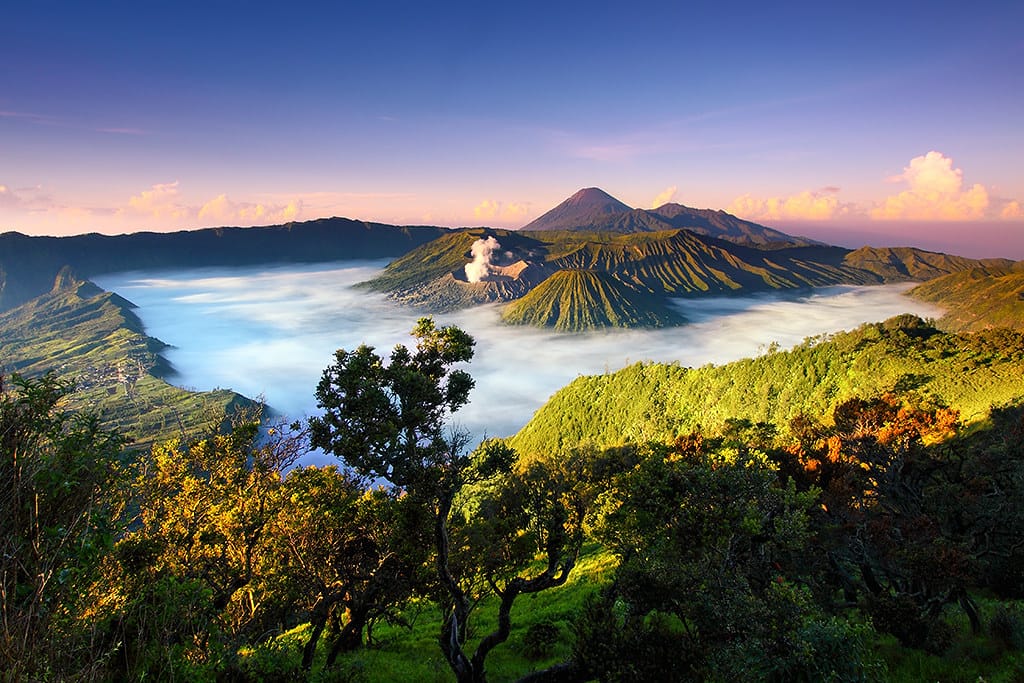
3 Underrated National Parks In Australia You Must-Visit
These three National Parks in Australia get a fraction of the visitors of some of their other national parks and I don’t understand why, because they are three of the most beautiful places on planet earth.
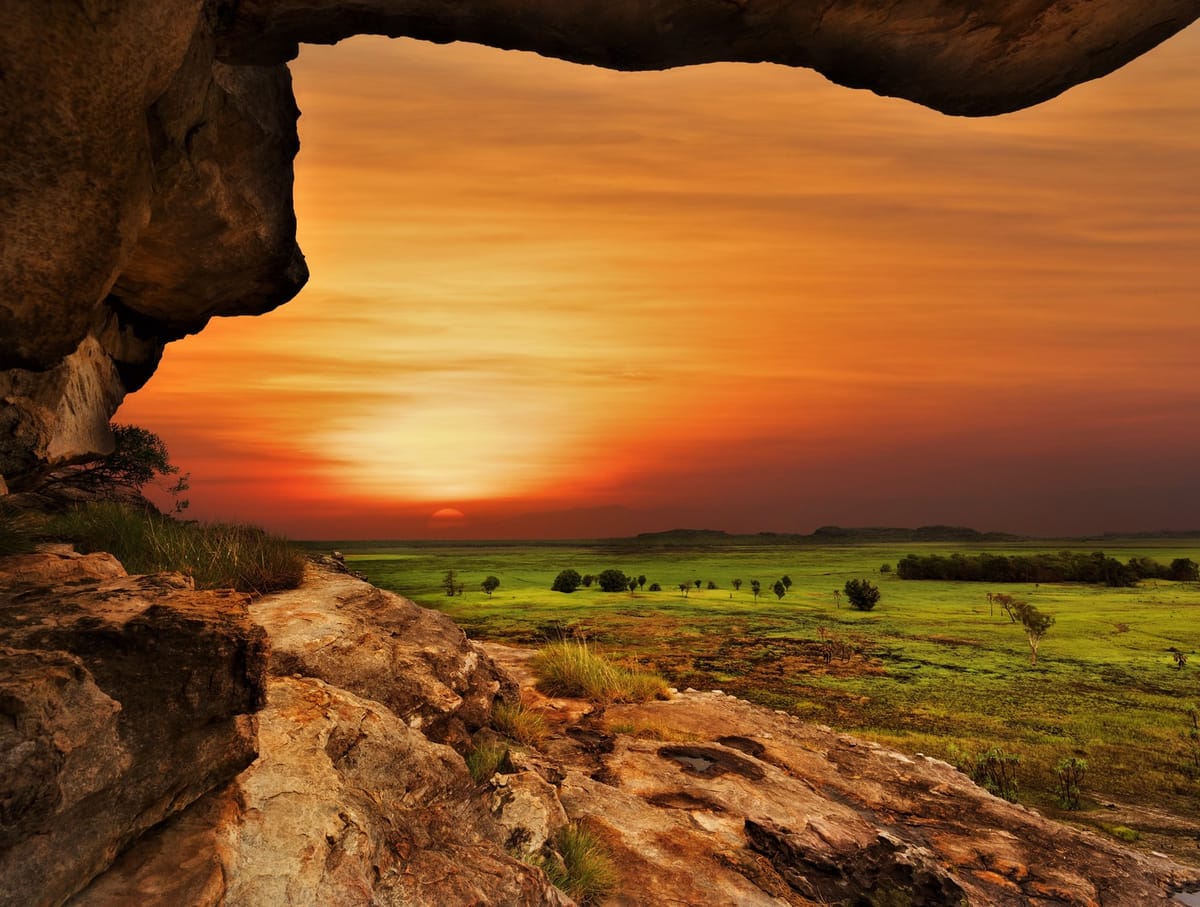
Komodo National Park - One Of Indonesia’s Top National Parks
Komodo National Park was established in 1980 to protect the Komodo dragon, and the park has since become a sanctuary for myriad species, both on land and in the surrounding waters of the Flores Sea. Let’s take a deeper diver into Komodo National Park.
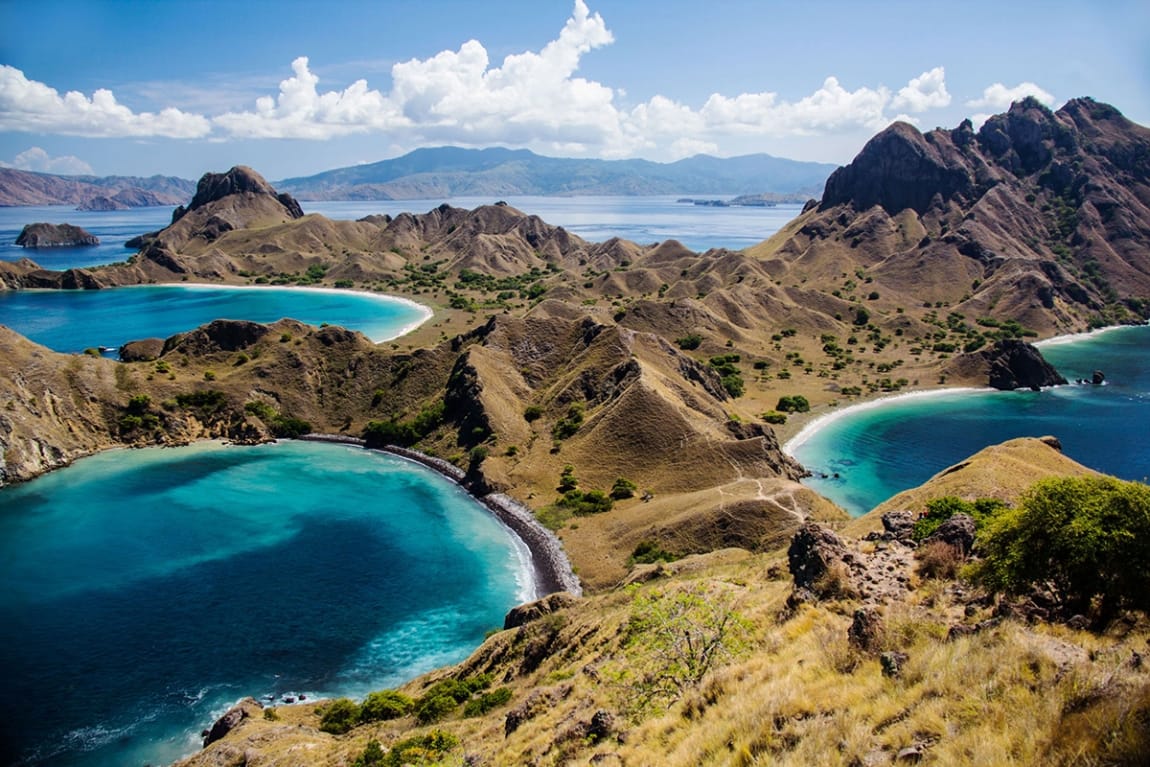
Ripping Lips - The Best Places To Fish In Banff National Park
If you love nothing more than throwing a line in the water in different beautiful destinations around the world, you’re in for a treat. In this guide we’re going to cover the best places to fish in Banff National Park.
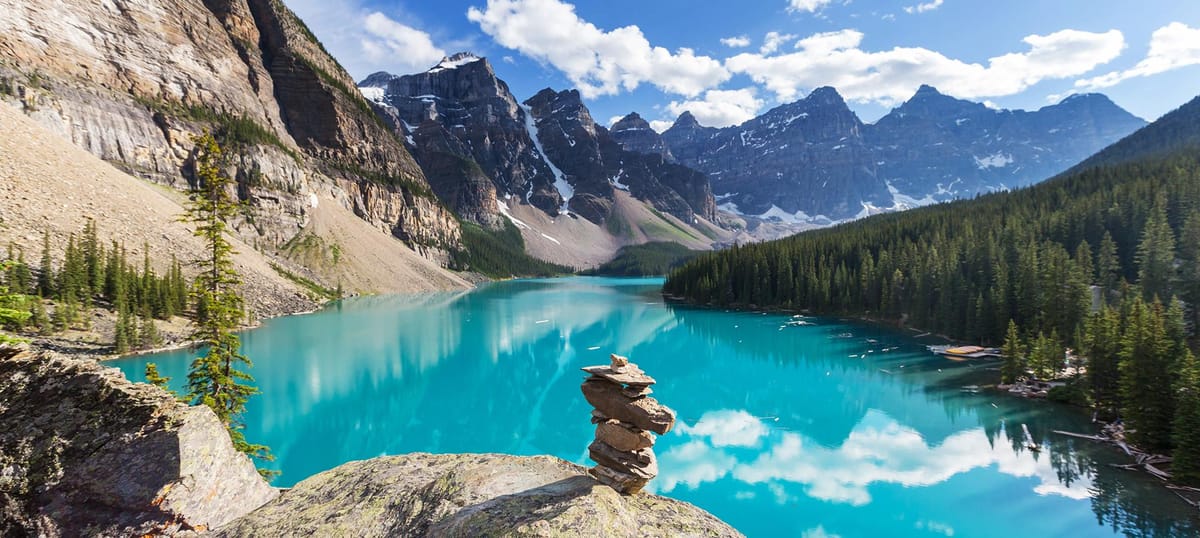
National Parks You Can Camp Anywhere In The Backcountry
In this guide, we list some U.S. National Parks that allow backcountry camping, and which parks allow you to camp anywhere, also known as “Anywhere Camping,” or dispersed camping. We’ll also let you know if the park requires permits, and any additional camping fees that must be paid.
